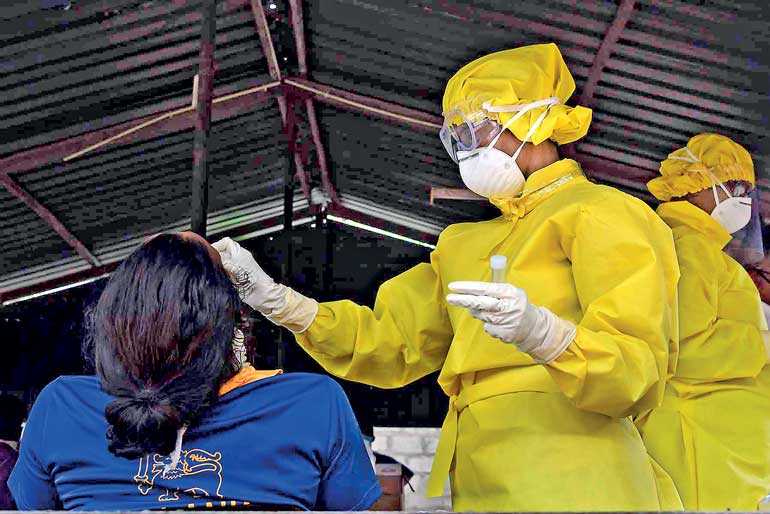Thursday Apr 25, 2024
Thursday Apr 25, 2024
Tuesday, 9 June 2020 00:00 - - {{hitsCtrl.values.hits}}

At the forefront of the country’s health battle against COVID-19 are women. The nursing fraternity is dominated by women and a staggering 62% of health and social work jobs are also being held by women – Pic by Shehan Gunasekara
The COVID-19 outbreak has brought our world to a standstill where many countries are in a locked-down state with very limited movements and activities. This is an unprecedented situation of which impact will be felt by almost all the sectors and spheres. The immediately felt are the sectors of health and economy. The most overlooked is the impact on women, an important resource which comprises 51.97% (World Bank, 2018) of the Sri Lankan population.
Women at the frontline
At the forefront of the country’s health battle against COVID-19 are women. The nursing fraternity is dominated by women and a staggering 62% of health and social work jobs are also being held by women (Ministry of National Policies and Economic Affairs, 2016).
As indicated by the Ministry of National Policies and Economic Affairs, in 2016 more than half of the medical students in Sri Lanka since 2000 have been women and around 70% of students enrolled in paramedics are also women. This is an indication of the level of representation and contribution women make in the battle against the pandemic, and also an indication as to how this important human capital generates return on investment (ROI).
Women’s economic participation
Despite these contributions by our women their participation in the world of work is limited to only one in three as estimated by the World Bank. This situation is even more critical as the Female Labour Force Participation has declined from 41% in 2010 to 36% in 2016 despite the expansions in the local economy. Keeping women away from the world of work is such a waste! This is a good indication of economic inefficiency. The more we keep women away from work, the more inefficient the economy will be.
Therefore it is the responsibility of both the organisational and national leadership to attend to this situation and to unleash the potential of an untapped, underutilised resource in achieving great economic value. This will also have a ripple effect in other spheres such as social, cultural, political and will yield a positive contribution towards the Sustainable Development Goals (SDGS).
Why are women held back?
A recently-conducted research published in Harvard Business Review by Robin J. Ely and Irene Padavic identifies the culprit as the unfavourable work practices adopted by the organisations. Specially the long work hours. This has resulted in overpromising and over delivering situations in the world of work with an attempt to delight the customers making the work practices unfavourable.
This is not unique only to women but equally fair on both men and women. However women seem to be paying the higher price due to family commitments as they are being considered as the “nurturer”. This claim seems true even in the Sri Lankan context where women seem to be struggling with their triple burden of work (family, social, work commitments).
Organisations attempt to cover such inefficient work practices by pointing fingers at women’s inability to reach the top and to break the glass ceiling. Also the firms are quick to offer work-family accommodations as solutions in the form of part time work, taking leave from work, reduced work hours, etc. Women with their family priorities tend to opt for these options which in the longer run hinder their ability to advance in their careers. This situation not only curtails their career but also causes gender pay gap where women get paid less than their male counterparts.
If the inefficient work practices such as long hours are keeping women away from the world of work and away from reaching the top, such practices need to be relooked at as it hinders macro level productivity negating the economic growth and value creation. No matter how much the companies claim “equal opportunities”, “non-discrimination”, if organisational norms and biases prevail and lip service is given to analysing and not addressing the real causes, effective changes to rectify the situation will not take place.
Another major factor to consider is “child care”. This is a problem area for many women in the world of work. Also a major contributor for the glass ceiling and gender pay gap. Thus this is an area which requires national level support and strategy. Research suggest that higher the maternity leave for women there is a better chance of retaining women in the work place and to assist them advance in their careers.
COVID-19 and new realities
As they say “every dark cloud has a silver lining”. COVID-19 is destructive. Yet there is something to take out in the midst of the destruction. The pandemic has brought in new realities, new thinking and practices to the world. One such is “Work from Home” concept (#WFH). This seems to be fitting perfectly well in solving some issues pertaining to the women’s participation in the world of work. #WFH is creating gender equality where both genders are compelled to work from home (not only women!).
Child care becomes a shared obligation. Women’s triple burden of work seems eased with shared responsibilities. There is coordination for once stereotyped and labelled chores such as cooking, washing and cleaning. #WFH seems to be “an option” worth exploring to encourage more women in the world of work. However this too comes at a cost and has its own limitations.
#WFH is limited to certain occupations, industries and work scopes. Thus the stretchability will be limited. Therefore a careful selection needs to be taken place prior to the adoption of the practice and if offered should be taken by both genders as a common work practice. Not alienating and trapping women within.
#WFM will require special infrastructural and technological literacy and efficacy. Thus the organisational and national leadership will need to explore avenues to achieve this and an investment will have to be made to equip the work force towards this. Thus creating a priority area worth exploring for post COVID-19 micro and macro level funding allocations. Moreover this new found reality will also assist to keep the costs and systems lean paving way for businesses to be more cost effective and competitive.
Further during the #stayathome time in Sri Lanka there has been a surge of domestic violence cases which has impacted both women and children. This is a result of social distancing and psychological pressures associated with-it. This is a common phenomenon in the Western world during the winter season where many are compelled stay indoors. Thus taking best practices from the West and with reference to the local scenario, a systematic approach needs to be developed to handle and to manage the negative side effects of #WFH practice. Further the development and deployment of a legal framework to support women need to be advocated and championed to make these new realities workable.
If these constraints can be identified and managed, #WFM seems a productive work practice the corporate fraternity can consider along with the Government to be implemented as a common work practice post COVID-19 which will have a positive impact on women’s economic participation and thereby on gender equality. #WFH will also help in building the post-pandemic economy both locally and globally.
[The writer is Founder and Chair, Women’s International Foundation (WIF). www.wifoundation.org.]